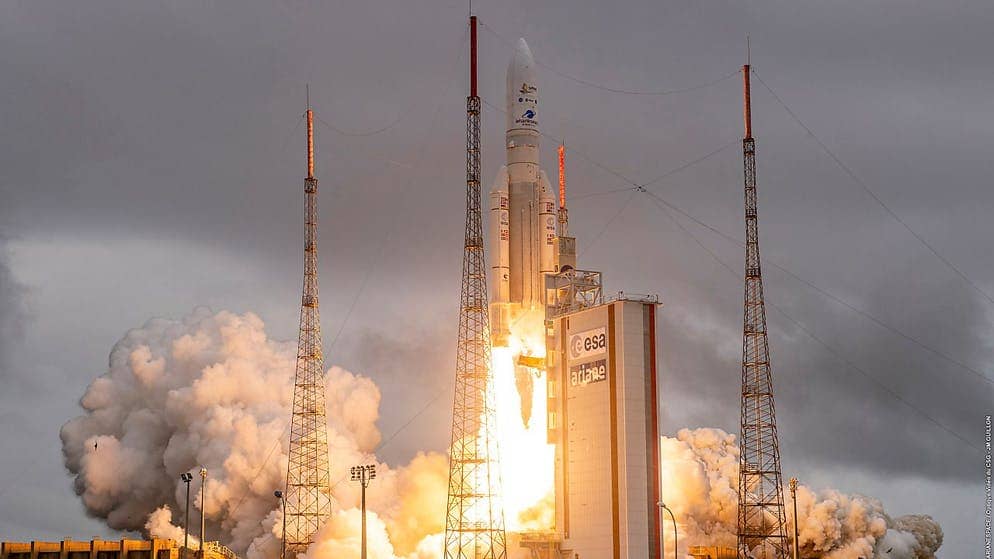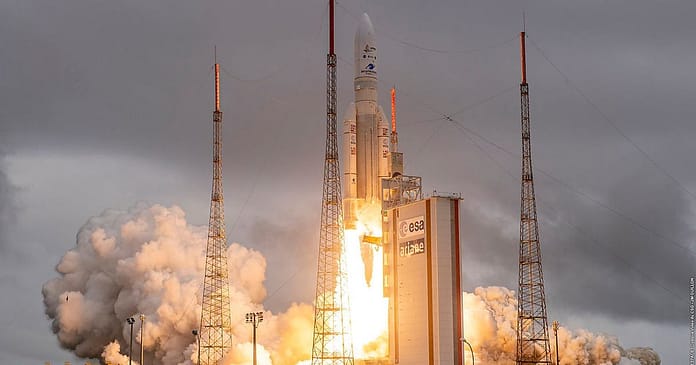
Photo: Keystone
After decades of preparation, the James Webb Space Telescope was finally launched into space on Saturday. It is now on its way to its target orbit 1.5 million km away. The trip takes about four weeks.
An Ariane 5 rocket lifted off from a spaceport in Kourou, French Guiana, at 1:20 p.m. CET and successfully launched the telescope shortly thereafter.
Before that start lies 30 years of development time, ten billion dollar costs and deferred starts over and over again. The James Webb Space Telescope (JWST) is the most expensive telescope in human history. It is now alone in its historic mission – and one of humanity’s most demanding space projects has been successfully launched.
The telescope will take about four weeks to reach its target orbit at a distance of about 1.5 million kilometers (about four times the distance between Earth and the Moon). There he will look at the universe deeper than any other telescope before, with the help of a 25-square-meter mirror.
For more than ten years, the telescope will explore the oldest galaxies in space — “James Webb begins his journey to the birth of our universe,” the commentator said in a NASA live broadcast.
Swiss contribution too
Among other things, the global research community hopes that Webb will provide information about the early period after the Big Bang, about 13.8 billion years ago. The immediate environment of the Earth in our solar system must also be examined. Web records should show, for example, whether there are habitable planets with water resources.
Swiss researchers are also pleased that James Webb has been hit in the universe. Several teams from Swiss universities were able to secure a desirable observation time with the space telescope and contributed four instruments aboard the space telescope. It is the machine that bears the name “Miri” (Mid Infr
“We have prepared a Christmas present for humanity around the world,” Josef Asbacher, Austrian director general of the European Space Agency, ESA, says shortly after the launch, then admits he was particularly excited. “I couldn’t do it every day, it wouldn’t be good for my life expectancy.”
The space agencies NASA of the USA, CSA of Canada and ESA of Europe collaborate with many other partners like never before – and not always under a good star. The specialized magazine “Nature” once wrote about “the most expensive astronomical hazard in history.”
The idea for this telescope first appeared at the end of the 1980s, and planning and construction have continued since then. The development was repeatedly delayed, which originally exploded at about $500 million. The telescope was originally supposed to start in 2007 – but the start has been repeatedly postponed.
Controversy over names
Subsequently, there was controversy over the name of the second director in NASA’s history. Webb was head of NASA in the 1960s — at times when the agency sent the first people into space, but also at times when an employee was fired on suspicion of being gay. Many scientists requested a name change, but current NASA chief Bill Nelson refused.
The James Webb Telescope is several times more powerful than the Hubble Telescope, which was launched in 1990. While Hubble works in the optical and ultraviolet range, James Webb searches in the near infrared. Astrophysicist John Mather once said that a telescope could “track a bee on the moon from Earth”.
The first data and images from the telescope are not expected until summer at the earliest – if all goes well. Initially, NASA identified 344 critical points during the mission that threatened the planned use of the telescope. The fact that the telescope flies so far has risks: while Hubble has been repaired and maintained several times with shuttle flights at an altitude of 500 km, this is no longer possible with JWST at a distance of 1.5 million km.
“Big reward always comes with great risk,” Bill Nelson said in a brief statement after the start on Saturday. He concludes with words that he considers appropriate to the importance of the moment: “God preserves the scholars and God preserves the planet Earth.”
sda / tgab







